A new Virginia study (PDF) finds that Metro and other transit operators carry a major portion of all cross-Potomac travel in a just a few crossings, using far less space than the 57 highway bridge lanes that carry the rest. If built, an expanded bridge crossing will need transit to maximize its ability to move people across the river.

Transit’s Role is Critical
While some media outlets focused on the study’s highway expansion recommendation, the presentation acknowledged that Metro, VRE, and other bus operators plays a major role in the movement of people across the river from Virginia to DC in the core of the region. Seeing that, we thought we we’d drill down further to estimate how many people are actually crossing the river, using which bridge, and by what mode. Supplementing the study with available transit ridership data and vehicle occupancy data (PDF), we arrived at the following estimates: Read more…
Categories: Impact Tags: bus, commuter bus, commuter rail, dc, maryland, Metrobus, Metrorail, mode share, Potomac River, travel patterns, Virginia, VRE
In part 2 of the series, StreetsCamp participants had a number of ideas to make buses better – all buses, not just Metrobus.
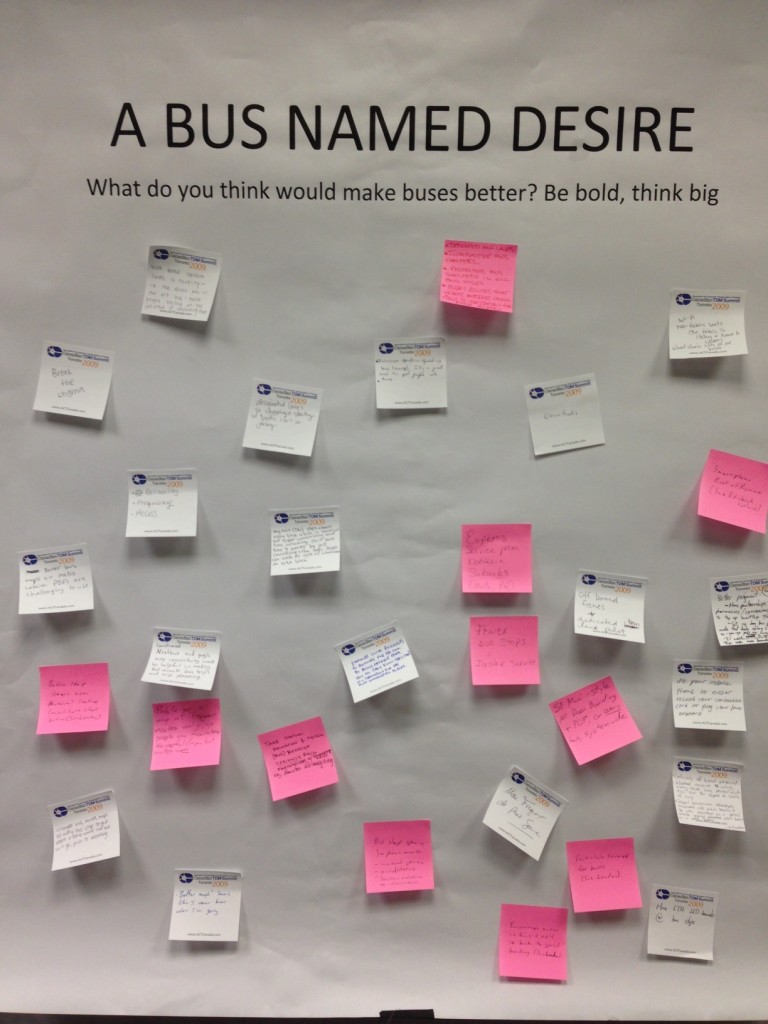 A Bus Named Desire was the question of the day at Metro Planning staff’s StreetsCamp session last Saturday. We asked what participants thought would make a better bus – from any perspective. What are the things that transit agencies and local jurisdictions could do speed up buses, increase the level of comfort for potential riders to ride the bus, change service, etc.
A Bus Named Desire was the question of the day at Metro Planning staff’s StreetsCamp session last Saturday. We asked what participants thought would make a better bus – from any perspective. What are the things that transit agencies and local jurisdictions could do speed up buses, increase the level of comfort for potential riders to ride the bus, change service, etc.
Here’s what we heard, grouped by topic:
Service
- Bus lanes, bus lanes, bus lanes (WMATA note – there are some great corridors for these. Please also let your city/county know you think they are important. They own and operate the streets!)
- Bus routes that offer better connections to destinations far from Metro stations
- Take station relocation and system redesign seriously. Build partnerships with community organizations. (WMATA note – both a regional approach, as well as line by line, are underway!)
- Consolidate stops on every line to save time and money. Buses don’t need to stop every block.
- More frequent off-peak service
- Add express service from Maryland suburbs
Read more…
In part one of this series, Metro Planners led a session at StreetsCamp Saturday June 20, 2015 to talk with transit advocates about other possibilities beyond Metrorail to increase transit use, reach, and access.
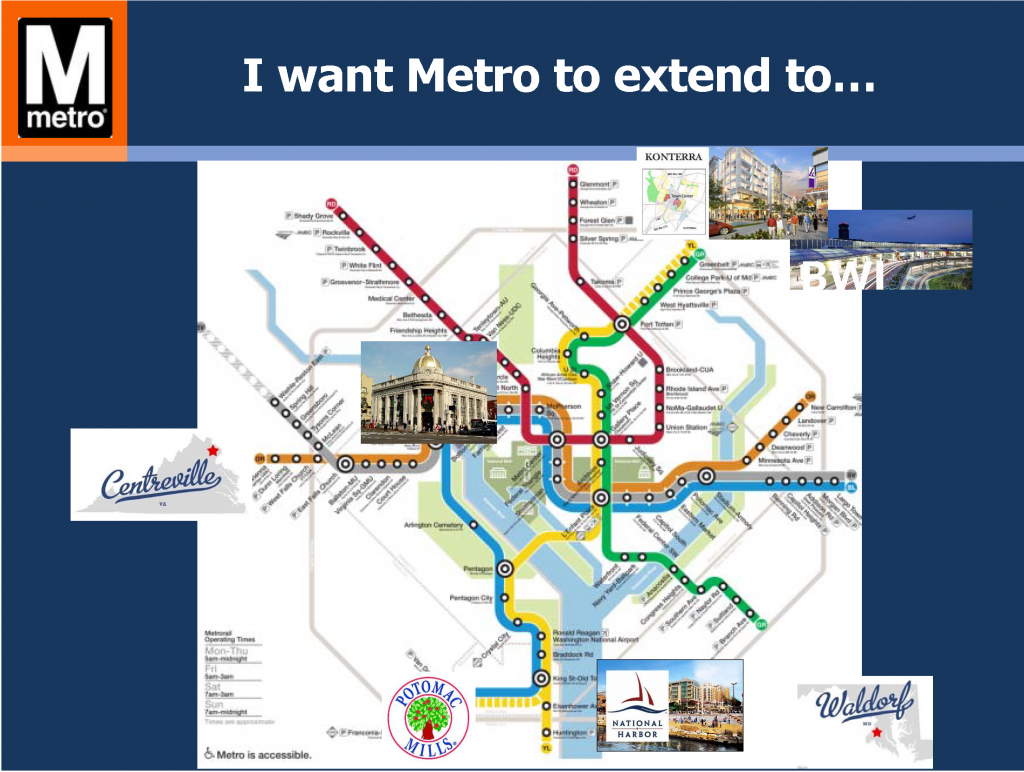
Politicians and citizens always ask for more Metrorail, but why should transit continue to chase land use decisions? Metro Planners Allison Davis and Kristin Haldeman talked to transit advocates and urbanists at StreetsCamp last Saturday to provide approaches that can help the transit we have today reach more people and be more cost-effective without requiring more Metrorail (pdf). The major take-aways for advocates and urbanists were to advocate for:
(1) Local decision makers to monetize full life‐cycle cost of land use options;
(2) Access projects that create comfortable (i.e. desirable) paths for pedestrians and bicyclists; and
(3) Local jurisdictions to add transit signal priority, queue jumps, and bus lanes
Why these three specifically? Read more…
Categories: In The News Tags: access, benefits, bus, business case, capacity, Metrobus, Metrorail, pedestrian, planning, plans, presentations, streetscamp, studies
As part of Metrobus’ June 21, 2015 Service Change, the Ballston-Bradlee-Pentagon Line has been eliminated and the Barcroft-South Fairlington Line has been revised.
The 25 routes have been evolving ever since the line started in January 1980. This route restructuring is only the latest change to better address the travel needs of our passengers. Routes 25A, 25C, 25D, and 25E (Ballston-Bradlee-Pentagon Line) have been eliminated. Most discontinued segments of the line have become part of the restructured Routes 22A, 22B, 22C, and 22F (Barcroft-South Fairlington Line).
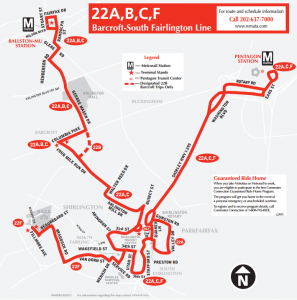
All timetables have been adjusted to reflect new trip times. Check out the 22A, B, C, F schedules and 25B schedule. Read more…
Categories: Service Changes Tags: 201506, 22A, 22B, 22C, 22F, 25A, 25B, 25C, 25D, 25E, bus, Metrobus, service change
As part of Metrobus’ June 21, 2015 Service Change, the Military Road-Crosstown Line will be restructured to better fit the travel needs of our riders.
Effective Sunday, June 21, 2015, we are changing the Military Road-Crosstown Line (E2, E3, E4) to improve the efficiency of the service, and to make the schedule easier to understand. Previously,
- E2 served Friendship Heights, Fort Totten, and Ivy City on weekdays, but on weekends, the E2 served only Friendship Heights to Fort Totten. E4 served Friendship Heights, Fort Totten, and Riggs Park on weekdays only.
- Weekend service was provided by a shortened E2, which traveled between Friendship Heights and Fort Totten only, and Route E3 (a weekend-only combination of the weekday E2 and E4, Route E3 served Friendship Heights, Fort Totten, Riggs Park, and Ivy City).
To better match service with demand, clarify the schedule, and increase reliability, we are restructuring the service starting on June 21:
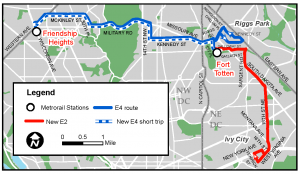
- Route E2 will be revised as the Ivy City-Fort Totten Line. The route will operate between Ivy City and Fort Totten station only, and will no longer connect to Friendship Heights station.
- Extra “short trips” on Route E4 will be added, which will connect Fort Totten and Friendship Heights station (bypassing Riggs Park).
- The E3 weekend designation will be eliminated, because the new E2 and E4 will operate seven days a week.
These changes will better balance service and demand, improve reliability, and allow for more service frequency on the high-demand western portion of the line. Shorter trips improve on-time performance and reliability, as a longer route is prone to more traffic chokepoints. A simplified schedule makes it easier to figure out which bus to take, especially for new riders. Check out the new E2 timetables here and the new E4 timetables here.
This post is Part 2 of 4 in a series spotlighting major changes from Metrobus’ June 2015 Service Change.
Categories: Service Changes Tags: 201506, bus, E2, E3, E4, Fort Totten, Friendship Heights, Ivy City, Metrobus, Riggs Park, service change
The U and V Lines have been overhauled as part of Metrobus’ June 21 service changes. Here’s what you need to know about the new and eliminated U and V routes.
In April 2014, Metrobus Planning staff directed a study of the U and V lines. The routes (U2, U4, U5, U6, U8, V7, V8, and V9), operate primarily in the District of Columbia, connecting the Minnesota Avenue Metrorail station with nearby neighborhoods. The study assessed the lines in detail, identified traffic issues and crowding concerns, and recommended service changes. As a result of the 2014 study, we have restructured the U and V lines to make them clearer and more reliable.
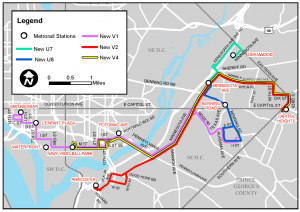
The following changes are effective Sunday, June 21, 2015:
- the elimination of Routes U2, V7, and V8,
- the shortening of Route U8,
- the restructuring of Route V9 as the new Route V1, and
- the addition of new routes U7, V1, V2, and V4.
Take a look at our detailed U and V Line brochure and the new timetables (U7, U8, V1, and V2,4) and let us know what you think of the new service.
There are no changes to the other U and V routes (U4, U5, U6, and V5).
This post is Part 2 of 4 in a series spotlighting major changes from Metrobus’ June 2015 Service Change.
Categories: Service Changes Tags: 201506, bus, Metrobus, planning, U2, U7, U8, V1, V2, V4, V7, V8, V9
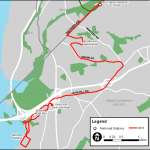
Metro’s bus planners always aim to provide you with a Better Bus, and on June 21, timetables are changing for over 40 bus routes. Here’s what you need to know, starting with a closer look at the NH1, NH3 line.
This post is Part 1 of 4 in a series spotlighting major changes from Metrobus’ June 2015 Service Change. Stay tuned for details on the revised E Line, U and V Lines, and 22 and 25 Lines.
Metrobus planners are constantly reviewing bus service and routes and bringing changes four times a year. Regular assessments including daily weekday passenger boardings and passengers per revenue trip, along with data from customer participation and feedback from our Metrobus operators, point out routes that need attention. Sometimes the resulting changes are small, such as adjusting trip times to more evenly space trips and better accommodate passenger loads or adjusting to traffic patterns. Other changes have a bigger impact, perhaps influenced by passenger demand, construction detours, budget constraints, or political pressures. No matter the reason, Metro Bus Planning is always working for a Better Bus.
Here’s what’s happening with the June 2015 service changes (detailed future timetables are available too): Read more…
Two years and 500,000 riders later, the K9 continues to demonstrates the benefits of MetroExtra limited-stop bus service.
At the end of this month, the K9 bus route will pass an important milestone – it will carry its half-millionth rider. Since its inaugural run, the K9 has continually surpassed all of our expectations.
The concept for the K9 emerged from a year long study on bus service needs in the New Hampshire corridor and on New Year’s Eve 2012, Metro launched the K9 service – the first limited-stop bus service introduced in Maryland in many years. The K9 provided faster and more reliable service along New Hampshire Avenue between Fort Totten Metrorail station and the Northwest Park apartments in Montgomery County. Riders responded enthusiastically, pushing the K9 over its 6-month target of 650 daily riders in less than four months. In March 2014, we extended the route north to the Federal Research Center in White Oak to coincide with the transfer of several thousand FDA employees to that facility and increased the service frequency to every 15 minutes. Ridership surged again, passing 1,000 daily riders for first time only a week later. Two months later daily ridership was up another 20% to 1,200 daily riders.
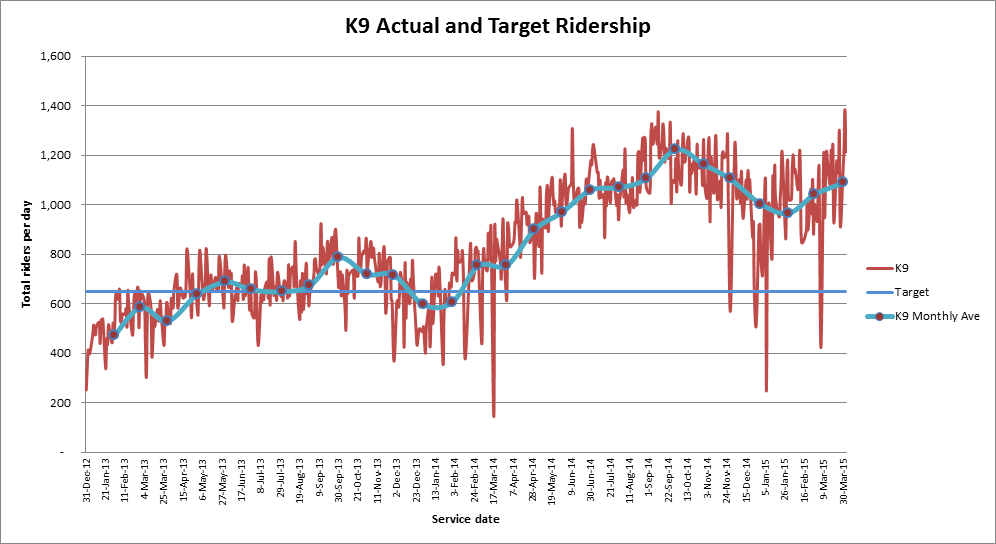
Ridership on the K9 has grown an astonishing 50% year-over year for the past two years in a row, and this growth has not come at the expense of ridership on the underlying K6 local bus service (the K6 grew 2% between 2013 and 2014 and has been virtually flat for 2015). Instead, the K9 has tapped into pent-up demand for transit service within the corridor by providing desperately needed capacity. Read more…
Metrorail has had a huge impact on the region, but as we’ve seen with the Silver Line, it can take decades to get from concept to execution.
One of the questions I hear most often as a planner for Metro is When will a Metro station open in xyz neighborhood, “in Georgetown”, or “at BWI”? It was the first question at the March Citizens Association of Georgetown meeting. My response — “Decades” — often elicits audible groans.
Given last summer’s opening of the Silver Line, we have a case study that can provide insight on how long it takes to plan, fund, and construct large infrastructure projects. The Dulles Corridor Metrorail Project has done a phenomenal job of maintaining a project timeline. Since the region has many recent newcomers, it is helpful to revisit many of the key milestones, as shown below. It is also helpful to remind readers that the Metropolitan Washington Airports Authority (MWAA) was the ultimate developer of the Silver Line (both Phases I and II) and that the project “only” required cooperation among the Commonwealth of Virginia, MWAA, Metro, the federal government, and Fairfax and Loudoun Counties. While just one example, the Silver Line’s long story is not vastly different from other mega-projects happening in the region and across the country.
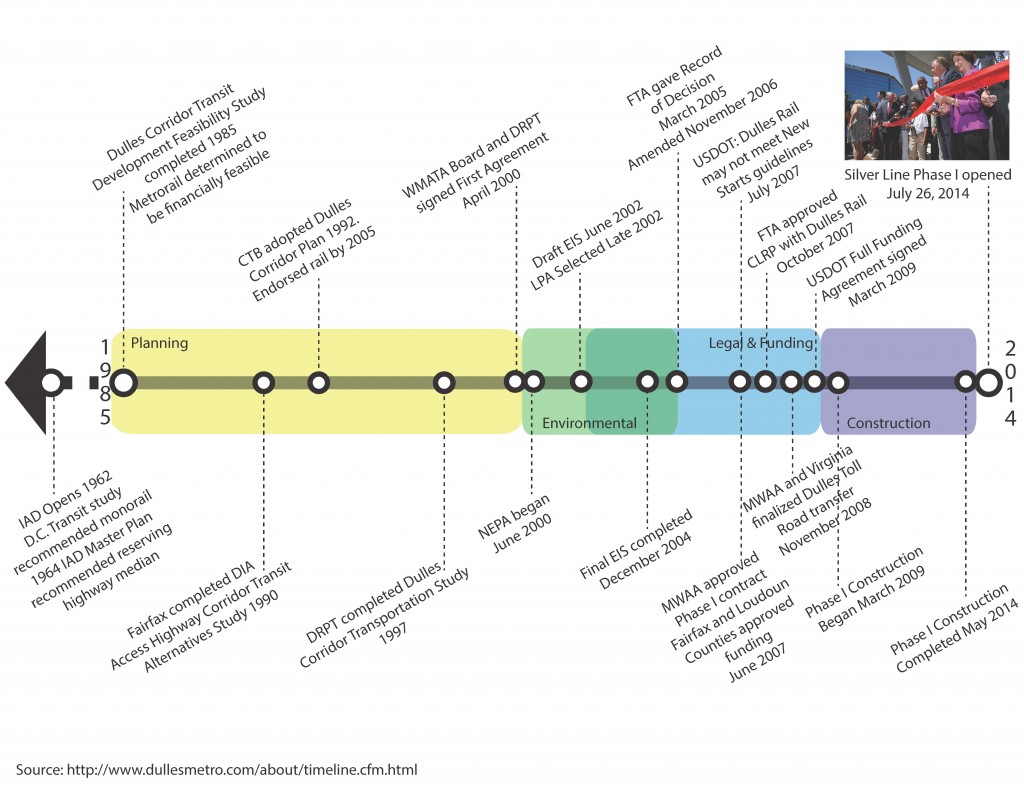
Timeline for Planning, Environmental Process, Legal and Financing, and Constructing the Silver Line
Read more…
Ridership on the X2 Metrobus line has jumped 14% after Metro changed the way the line is managed.
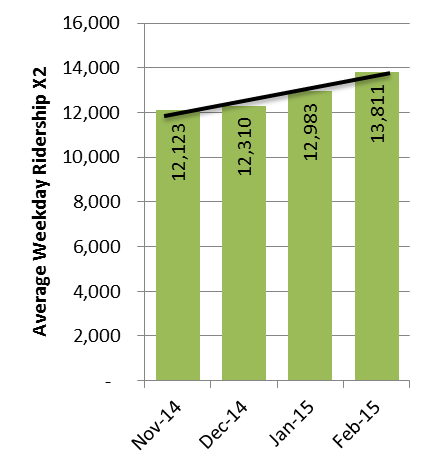
The X2 bus on the busy H Street/Benning Road corridor has always been one of Metro’s busiest routes at over 13,000 riders per day. (If the X2 were a Metrorail station, it’d rank just above Silver Spring and just below Rosslyn!)
Through most of 2014, the X2’s on-time performance (OTP) averaged about 65% – well below Metro’s goal. Insufficient running time in the schedule, and disruptions from planned and unplanned detours along the route created uneven spacing between buses leading to “bus bunching” and long gaps between buses. These service gaps often led to significant overcrowding, particularly during the midday period.
So to improve reliability, we made some changes in December 2014:
- To meet demand, we increased the frequency of buses to an even 8 minutes all day long – 6:00am-7:00pm on weekdays.
- We deployed a team of dedicated supervisors on the street (at Minnesota Avenue and Lafayette Square) and at the Bus Operations Control Center to ensure even spacing between buses on weekdays. The X2 is now a “headway-managed” route on weekdays, meaning our primary goal is to maintain buses evenly every 8 minutes throughout the day.
- We adjusted the scheduled running times by about 15% for all trips.
The results have been impressive: ridership has jumped 14% from 12,700/day in October 2014 to 13,800 in February, overcrowding (particularly during the midday) has been virtually eliminated, and on-time performance has grown to 83% – a remarkable achievement for a heavily congested urban corridor.


 A Bus Named Desire was the question of the day at Metro Planning staff’s StreetsCamp session last Saturday. We asked what participants thought would make a better bus – from any perspective. What are the things that transit agencies and local jurisdictions could do speed up buses, increase the level of comfort for potential riders to ride the bus, change service, etc.
A Bus Named Desire was the question of the day at Metro Planning staff’s StreetsCamp session last Saturday. We asked what participants thought would make a better bus – from any perspective. What are the things that transit agencies and local jurisdictions could do speed up buses, increase the level of comfort for potential riders to ride the bus, change service, etc.








Recent Comments